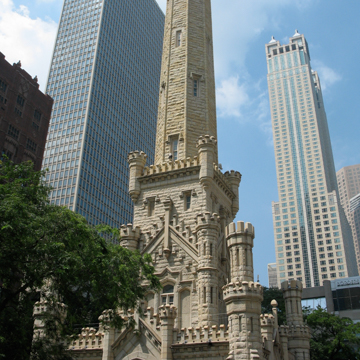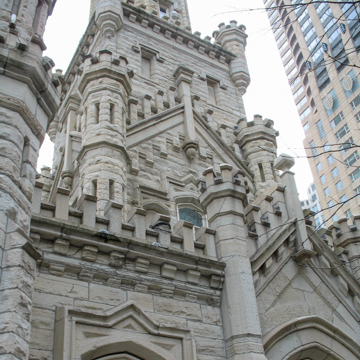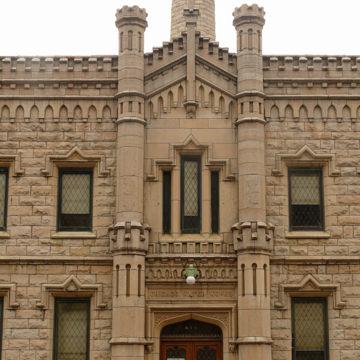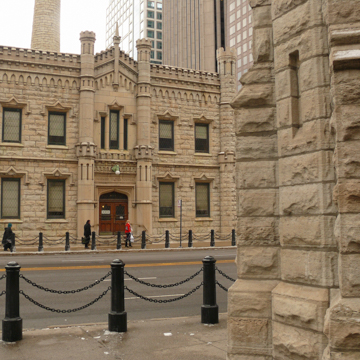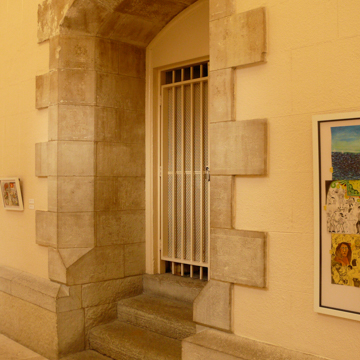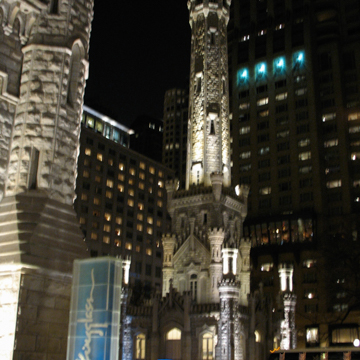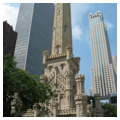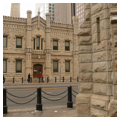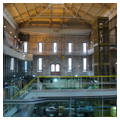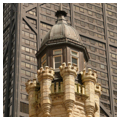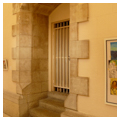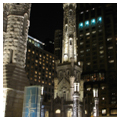You are here
Chicago Water Tower and Pumping Station
The Chicago Water Tower and Pumping Station were originally at the city’s northern edge, and were among the few structures to have survived the Fire of 1871. They are now iconic symbols of the city’s past, surrounded by the bustling North Michigan Avenue retail district and dwarfed by office and residential high-rise towers. Both structures were designed by William W. Boyington, one of Chicago’s most prolific late-nineteenth-century architects.
The Pumping Station (811 North Michigan Avenue) is the older of the two structures. Dating to 1866, it was built to receive fresh water, via underground pipes, from access “crib” structures a mile out into Lake Michigan. This building is dominated by a 60 x 142-foot engine room featuring a 36-foot-tall ceiling and encircled by a mezzanine. Boiler rooms and a tall limestone smokestack are located to the east of the engine room. The building’s exterior is yellow limestone from quarries in nearby Joliet and Lemont. It is ornamented in a Gothic Revival style, featuring cut stone battlements and a low-pitched hipped roof.
The Water Tower (806 North Michigan Avenue) was built three years later to house (and disguise) a 138-foot-tall standpipe used to stabilize the city’s water pressure. Located to the west of the Pumping Station, it also built of Joliet-Lemont limestone. Its appearance, however, is substantially more ornate than the somewhat utilitarian-looking pump house, bringing the castellated Gothic style to its full expression. On a visit in 1882, British writer and renowned wit Oscar Wilde called the water tower a “castellated monstrosity” so redolent of the middle ages that “one expects to see mailed knights peering out.”
The tower is set on a 40 x 40-foot base that diminishes in size over its 154-foot height. Each of the four facades is identical, with center entrances flanked by pointed arch windows and drop moldings. Small corner towers and battlements provide decorative emphasis at each of the three lower levels, while the octagonal shaft is capped by a cupola featuring eight tourelles. Inside the tower, a 9-foot-wide vestibule surrounds the base of the standpipe, which long ago was replaced by a 237-step staircase.
The buildings were threatened with demolition on several occasions—in 1906, 1918, and 1948—due to a proposed road widening and pressures from drastic urban change in the immediate vicinity. In 1962–1963, both buildings were restored, which included the substantial replacement of deteriorated stone with new limestone.
In 2003, much of the Pumping Station—except the still-functioning engine room—was converted to a live theater venue, as part of the surrounding area’s ongoing redevelopment into a museum and retail district. Similarly, the Water Tower was converted to use as an art gallery space for the City of Chicago.
References
Koeper, Frederick. Illinois Architecture from Territorial Times to the Present. Chicago: University of Chicago Press, 1968.
Sinkevitch, Alice, ed. AIA Guide to Chicago. Orlando, FL: Harcourt, 2004.
Taussig, Meredith. Summary of Information for the Water Tower and Chicago Avenue Pumping Station. Chicago: Commission on Chicago Historical and Architectural Landmarks, 1984.
Writing Credits
If SAH Archipedia has been useful to you, please consider supporting it.
SAH Archipedia tells the story of the United States through its buildings, landscapes, and cities. This freely available resource empowers the public with authoritative knowledge that deepens their understanding and appreciation of the built environment. But the Society of Architectural Historians, which created SAH Archipedia with University of Virginia Press, needs your support to maintain the high-caliber research, writing, photography, cartography, editing, design, and programming that make SAH Archipedia a trusted online resource available to all who value the history of place, heritage tourism, and learning.

